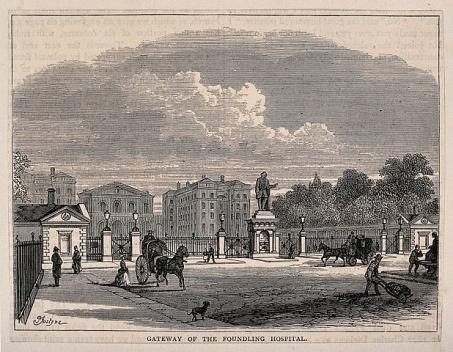b.1859c-d.1909c
Sadly Louisa was a foundling, born circa 1859 -1860, most likely in the London area.
Foundlings on admission to the hospital were baptised, renamed and given an admission number.

The Foundling Hospital in London, England, was founded in 1739 by the philanthropic sea captain Thomas Coram. It was a children’s home established for the ‘education and maintenance of exposed and deserted young children’.
The “System” for care of foundlings.
This guide is taken from the London Metropolitan Archives.
Admissions
Children under 12 months were admitted subject to regulations set down by the General Committee.
The mother had to present a petition explaining the background, these were not always accepted.
Once admitted, the children were baptised and renamed, each being identified by an admission number.
Nursing
The children were dispatched to a wet or dry nurse in the country. These nurses were mostly in the Home Counties but could be as far as West Yorkshire or Shropshire. Nurses were monitored by voluntary Inspectors.
School
Once the children had reached the age of between 3 and 5 they were returned to London to the Foundling Hospital. Apart from reading classes, there were practical tasks, music classes and sewing projects.
Apprenticeships
Children were apprenticed to trades or service or enlisted to serve in the armed forces.
1860s
The 1861 Census finds a Louisa Harlock age 1, a foundling, birth place unknown, living with William and Elizabeth Jeffery. William aged 43 is an agricultural labourer from Peckham, Elizabeth is 34. They have 5 children, Henry 14, Louisa 9, Edward 7, Mary 4 and Marshall 1. Another foundling Henry Lupton 3 is also living with them in ‘The Pound’ East Peckham.
The Pound was one of nine hamlets that straddled the river Medway. It was economically focused on hop growing and other agriculture.
1870s
The 1871 Census finds Louisa Horlock aged 12, is now living in the London Foundling Hospital. Guildford Street, St Judes, St Pancras, London. Girls were taught Domestic skills including sewing.
I could not find any online documents for Louisa leaving the Foundling Hospital as a domestic servant, until she is admitted to Woking Asylum from Camberley Workhouse.
1880s
On 26th June 1880, Louisa Horlock, a domestic servant of last abode Camberley Workhouse, is admitted to Brookwood Asylum in Woking Surrey.


In the 1881 census she is still a patient, born in Kensington.

On 21st November 1882, she is transferred to Banstead Asylum and is later discharged on 16th March 1883, as recovered.
1890s
In 1891, a possible Census entry shows Louisa Horlock, a parlour maid born unknown in London. Head of house is Elizabeth G Twiname 69, a widow, who is living on her own means with her daughter Janet 40, Mary Walter 25, a cook and Janet Heaven 22, a housemaid. Enfield Lodge, Lillington Warwickshire. In March 1898 Elizabeth Twiname dies.
Louisa is found a year later again in an Asylum. On 12th July 1899 Louisa Horlock admitted to Sussex Asylum and is discharged 6th October.

On 16th October 1899 Louisa Harlock admitted to East Sussex Asylum.


1900s
On 30th October 1902 she is transferred to Horton Asylum Epsom and stayed until she died on 23rd October 1909.
The death certificate shows Louisa’s residence as 1 Upperton Gardens, Eastbourne, Sussex. This corresponds with the lunacy records of the Sussex Asylum. She is a servant.
The cause of death is Lymphadenoma, probably 3 years, an now obsolete term for Lymphoma/Hodgkin’s disease. Other details are chronic interstitial nephritis, a kidney disorder and fatty degeneration of heart. No mention of her mental illness.

Louisa Harlock was buried in Horton Cemetery Grave 507A on 28th October 1909.
Author’s Thoughts
I have searched London workhouse records with no results. The Brookwood Admittance record has her coming from Camberley Workhouse.
If my search is correct Louisa travelled from the Midlands to the South of England to find work. Whether she did this herself or had connections to aid her search for work is not known. Sadly Louisa, being a foundling, had no family ties and she made a home for herself by being ‘in service’ to others.
Another possibility I found isI in the 1911 Census for 1,Upperton Gardens was a GFS Lodge. I am assuming this is the Girls Friendly Society. Taken from the history of the society:-
The GFS was founded on 1st Jan 1875 by Mary Elizabeth Townsend, an Irish clergyman’s daughter married to the wealthy Frederick Townsend. The society was established with the support of the Anglican Church as a pioneer Youth organisation to protect working-class country girls who had left home to take up urban employment.
Perhaps Louisa was mentored by the Lady Associates and this is how she found work and a home.
A brave lady, who suffered unknown mental health issues.



